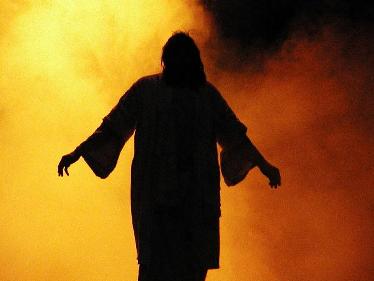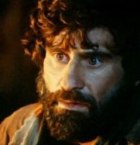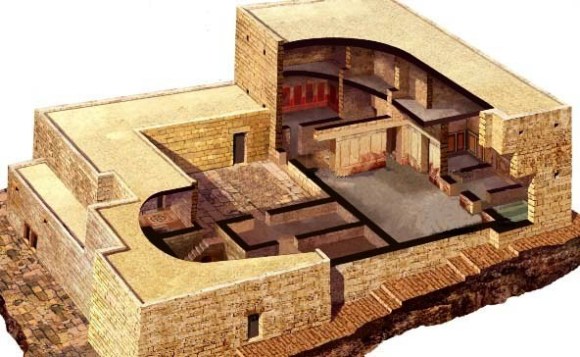Jesus to Thomas ‘Doubt no more!’
Questions for Bible study groups
- What sort of man was Jesus’ disciple Thomas?
- What pivotal moment did Thomas miss?
- What changed Thomas’ mind?
Thomas was a close friend and disciple of Jesus while he lived, but this practical man simply did not believe the other apostles when they said that Jesus was risen from the dead. Jesus appeared to him and showed him the wounds left by the nails and the spear. ‘Now do you believe?’ asked Jesus.
Doubting Thomas
In the days after the Resurrection, there was a great deal of arguing and counter-arguing, of rumor and counter-rumor. A number of the disciples were convinced that Jesus was risen; there were probably many who scoffed at the idea. It simply was not possible, they would have argued.
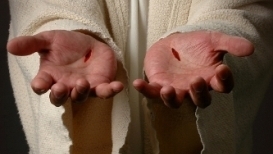 Among the scoffers was Thomas, presumably present at the Last Supper, possibly watching from afar when Jesus was crucified, and until this fatal week in Jerusalem a faithful follower of Jesus. But he had missed a pivotal moment: he was not present when Jesus appeared to the other disciples on the evening of Easter Sunday. He had not seen, as they had, the living Jesus.
Among the scoffers was Thomas, presumably present at the Last Supper, possibly watching from afar when Jesus was crucified, and until this fatal week in Jerusalem a faithful follower of Jesus. But he had missed a pivotal moment: he was not present when Jesus appeared to the other disciples on the evening of Easter Sunday. He had not seen, as they had, the living Jesus.
He seems to have been a sensible, down-to-earth man, not given to rash judgments. Now he found it impossible to believe what many of the other disciples were believing: that Jesus had risen from the dead, and was alive and among them. He was not given to hiding his opinion: he expressed it freely. He would believe, he said, when he has actually put his hand into the horrible wounds that were left by the nails and the spear, when Jesus was crucified. He wanted physical evidence to show that the risen Jesus was the same Jesus he had known.
See the blue text in What The Gospels Say at end of page
Thomas doubts no more
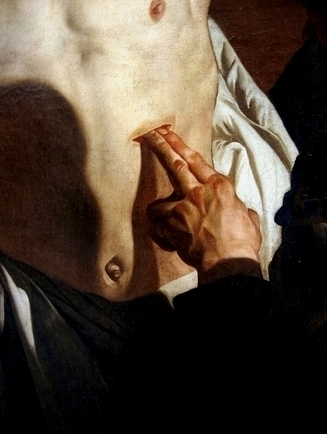 A week later the disciples, including Thomas, were gathered in a house – we do not know where. The doors of the house were locked – the disciples were still afraid. But suddenly Jesus was among them. This in itself was astonishing, and seems, like the other appearances of Jesus, to suggest that Jesus’ resurrected body was not governed by the normal laws of Nature.
A week later the disciples, including Thomas, were gathered in a house – we do not know where. The doors of the house were locked – the disciples were still afraid. But suddenly Jesus was among them. This in itself was astonishing, and seems, like the other appearances of Jesus, to suggest that Jesus’ resurrected body was not governed by the normal laws of Nature.
Jesus’ first words were ‘Peace be with you’ – a traditional greeting, but perhaps also a sort of ‘Steady on, chaps’ to the disciples, who would have been alarmed and dis-oriented by his sudden appearance among them.
Jesus then turned to Thomas, and told him to place his fingers in the nail wounds in his hands. He told Thomas to place his hand in the gaping wound in his side, where the soldier’s spear had pierced. In doing so, he showed Thomas that he somehow knew what Thomas had been saying.
‘Believe’ commanded Jesus.
Notice Thomas’ response: he calls Jesus not only Lord, but names him God as well.
There was a gentle reproach in Jesus’ response: Thomas believed because he saw with his own eyes that it was Jesus, risen from the dead. How much more blessed were people who never saw Jesus, never heard his voice, but believed in him as Lord and God.
This has applied to all believing Christians since the time of Jesus.
See the green text in What The Gospels Say at end of page
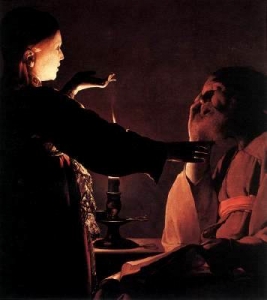 There was a more civilized alternative to death by stoning: a quiet divorce. This is what Joseph decided to do.
There was a more civilized alternative to death by stoning: a quiet divorce. This is what Joseph decided to do.
Something now happened in the story that changed world history. Joseph had a dream, a very powerful one, in which he was guided by God to take Mary as his wife.
The text describes the message as coming from an ‘angel’, without going into details of what it meant by ‘angel’. Biblical writers seemed to have used the word as a sort of code: the message of an ‘angel’ meant that a deep conviction settled on a person that God had a particular purpose or plan, and that they were part of it. They must follow this purpose through to the end, even if it did not seem to make sense to them. They must simply trust in God.
The dream/angel told Joseph to marry Mary, even though he knew the child would not be his. This he did. Then, awed by the dream and God’s message, he decided to abstain from sexual relations with her until after the baby was born.
Return to top
What the Gospels say
1. Doubting Thomas. Read the blue text
2. Thomas doubts no more. Read the green text
John 20:24-29
24 Now Thomas, one of the twelve, called the Twin, was not with them when Jesus came. 25 So the other disciples told him, “We have seen the Lord.” But he said to them, “Unless I see in his hands the print of the nails, and place my finger in the mark of the nails, and place my hand in his side, I will not believe.”
26 Eight days later, his disciples were again in the house, and Thomas was with them. The doors were shut, but Jesus came and stood among them, and said, “Peace be with you.” 27 Then he said to Thomas, “Put your finger here, and see my hands; and put out your hand, and place it in my side; do not be faithless, but believing.” 28 Thomas answered him, “My Lord and my God!” 29 Jesus said to him, “Have you believed because you have seen me? Blessed are those who have not seen and yet believe.”
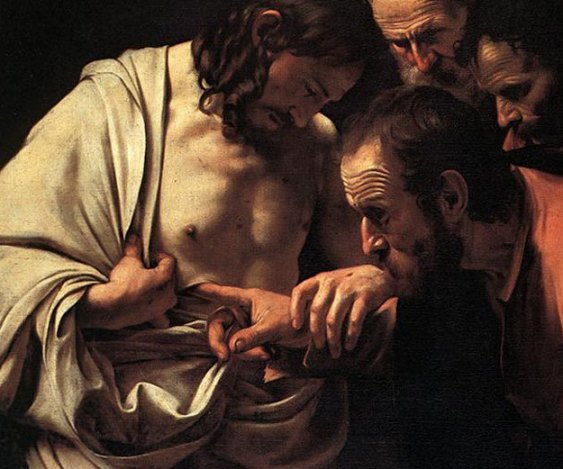
Jesus with doubting Thomas, Caravaggio

